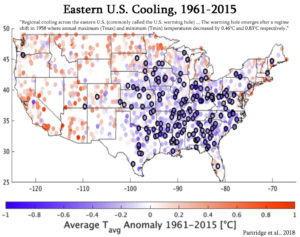by K. Richard, January 14, 2019 in NoTricksZone
There are large regions of the globe where observations indicate there has been no warming (even cooling) during the last decades to century. Climate models rooted in the assumption that fossil fuel emissions drive dangerous warming dismiss these modeling failures and project temperature increases of 3° – 10°C by 2100 for these same regions anyway.

Image Source: Partridge et al., 2018
…
by Research Organization of Information and Systems, January 15, 2019 in ScienceDaily
Two new species of fungi have made an appearance in a rapidly melting glacier on Ellesmere Island in the Canadian Arctic, just west of Greenland. A collaborative team of researchers from Japan’s National Institute of Polar Research, The Graduate University for Advanced Studies in Tokyo, Japan, and Laval University in Québec, Canada made the discovery.
The scientists published their results on DATE in two separate papers, one for each new species, in the International Journal of Systematic and Evolutionary Microbiology.
“The knowledge of fungi inhabiting the Arctic is still fragmentary. We set out to survey the fungal diversity in the Canadian High Arctic,” said Masaharu Tsuji, a project researcher at the National Institute of Polar Research in Japan and first author on both papers. “We found two new fungal species in the same investigation on Ellesmere Island.”
…
by Dr. Jean N., 16 janvier 2019 in ScienceClimatEnergie
La théorie radiative de l’effet de serre prédit que la température de la basse atmosphère augmente lorsque le taux de CO2 croît. Si l’on prend par exemple une très vaste région, comme la Chine centrale ou le Midwest américain, qui couvrent tous deux des centaines de milliers de km2, on devrait donc observer un accroissement des températures moyennes de la basse atmosphère en fonction du temps. Effectivement, dans ces régions, et comme pour tout l’hémisphère Nord, le taux de CO2 n’a fait qu’augmenter depuis le début des mesures par spectrométrie infra-rouge en 1959. Cependant, une étude récente vient de montrer que la température moyenne n’aurait pas augmenté dans ces vastes régions, et ce malgré l’augmentation du taux de CO2 atmosphérique. L’étude en question a été publiée dans Energy & Environment en 2018 par deux chercheurs danois de la Danish Technical University, Frank Lansner et Jens Pedersen. Il faut rester prudent, mais si cette étude est confirmée, il s’agirait d’un sérieux problème pour la théorie radiative de l’effet de serre.
…
Figure 1. Anomalie de température pour la Sibérie centrale entre 1900 et 2010 (voir article)
…
by P. Homewood, January 15, 2019 in NotaLotofPeopleKnowThat
Antarctica is shedding ice at a staggering rate.
Scientists have discovered global warming has caused the melting of the ice on the continent to increase sixfold since 1979.
This phenomenal rate of melting has seen global sea levels rise by more than half an inch – and experts predict it will get worse.
Scientists have predicted a ‘multi-meter sea level rise from Antarctica in the coming centuries’ as a result of the vast loss of ice.
Researchers discovered that, between 1970 and 1990, the continent was shedding an average of 40 gigatons of ice mass annually.
This jumped to an average of 252 gigatons a year between 2009 and 2017.
https://www.dailymail.co.uk/sciencetech/article-6590841/Antarctica-losing-SIX-TIMES-ice-year-1970s.html#newcomment
You may of course recall that it was only three years ago that the same NASA, who are behind this latest scare story, were telling us that the ice cap was actually growing in Antarctica. But more of that in a minute.
There are several aspects to this latest story that need closer examination.
…
La géologie, une science plus que passionnante … et diverse


